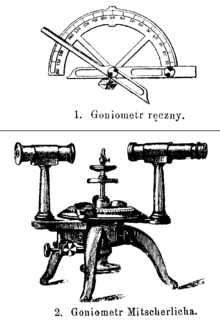Goniophotometer
A Goniophotometer is a device used for measurement of the light emitted from an object at different angles.[1] The use of goniophotometers has been increasing in recent years with the introduction of LED-light sources, which are mostly directed light sources, where the spatial distribution of light is not homogeneous.[2] If a light source is homogeneous in its distribution of light, it is called a Lambertian source.[3] Due to strict regulations, the spatial distribution of light is of high importance to automotive lighting and its design.

Uses
A goniophotometer can be used used for various applications:
- Measurement of luminous flux of a light source
- Measurement of luminous intensity distribution from a source much smaller than the size of the goniophotometer
Equipped with color sensors additional characteristics can be measured
- Distribution of correlated color temperature
- Color uniformity
Types
The various types of goniophotometer are defined here[4] which is derive from publication "CIE 70" from the International Commission on Illumination.[5]
Type A
Fixed horizontal axis, with the vertical axis attached, both perpendicular to the main output direction of the light source
Type B
Fixed vertical axis, with the horizontal axis attached, both perpendicular to the main output direction of the light source
Type A and B are Double columns structure. This type is applied to fixed the grille lamp. The symmetry axis of lamp and the horizontal of rotating supporter is coaxial, in the B-βcoordinate system, and the two is vertical Cross, in the A-αcoordinate system.
Type C
Fixed vertical axis perpendicular to the line of measurement, with a horizontal axis parallel to the main output direction of the light source
Type C are single column structures. The single column structure is created when the assistant column is taken down from double columns structure. This type is applied to a fixed tube lamp, spot lamp, or other devices. The axis radiation of lamp and the horizontal of rotating supporter is coaxial.
References
- Marx, P. (1997). "New goniophotometers for light-engineering laboratories" (PDF). Light & Engineering. 5 (4): 32–36.
- Lindemann, Matthias; Maass, Robert (15 December 2009). "Photometry and colorimetry of reference LEDs by using a compact goniophotometer". MAPAN. 24 (3): 143–152. doi:10.1007/s12647-009-0018-6.
- Palmer, James (2010). The Art of Radiometry. Bellingham, Washington: SPIE. p. 27. ISBN 9780819472458.
- "The goniometer types A / B / C". http://www.optronik.de. Retrieved 11 November 2015. External link in
|publisher=(help) - CIE 70, The Measurement of Absolute Luminous Intensity Distributions. Vienna: CIE. 1987.